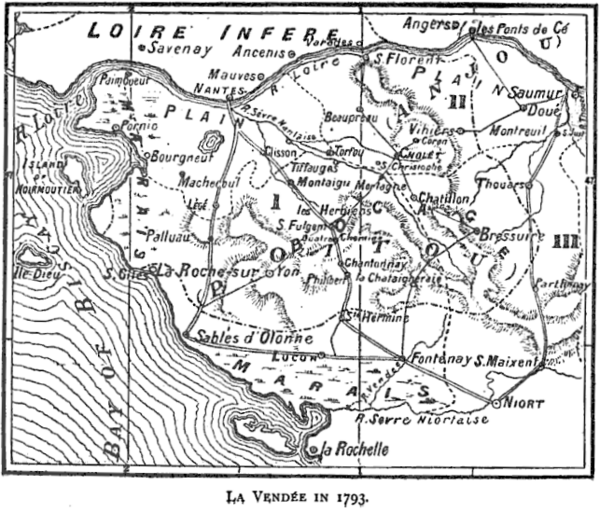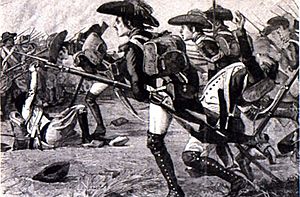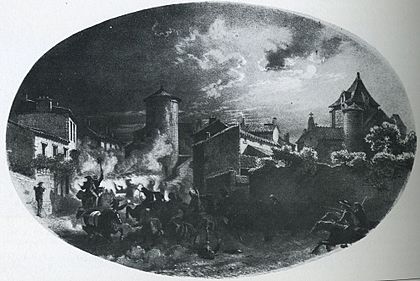Charles Aimé de Royrand facts for kids
Quick facts for kids
Charles Aimé de Royrand
|
|
|---|---|
| Born | 14 March 1726 Saint-Fulgent, France |
| Died | 5 December 1793 (aged 67) Baugé-en-Anjou, Maine-et-Loire, France |
| Allegiance | |
| Service/ |
|
| Years of service | |
| Battles/wars |
|
| Awards | Order of Saint-Louis |
Charles Aimé de Royrand (born March 14, 1726 – died December 5, 1793) was an important leader during the War in the Vendée. This war was a major revolt against the French Revolution in France.
Before the revolt, Charles Aimé de Royrand served in the French Royal Army. He fought as a soldier in the American Revolutionary War. After that, he retired in 1780 to live on his land. When the Vendée rebellion began in 1793, he was chosen to lead the southern part of the rebel army. He led his forces in several battles, including Luçon, Cholet, and Entrames. He was badly hurt at the Battle of Entrames and died later in Baugé-en-Anjou.
Contents
Charles Aimé de Royrand's Early Life
Charles Aimé de Royrand was born on March 14, 1726, in Saint-Fulgent, France. He was one of four sons. All three of his older brothers were also named Charles.
He joined the Navarre Infantry Regiment, which was a military unit. Later, he moved to the Armagnac Regiment. He fought in the American Revolutionary War. He might have also fought in the French and Indian War before that.
In 1780, he returned to France and stopped being a soldier. He went to live on his properties near Saint-Fulgent. For his service in the military, he received an award called the Order of Saint-Louis.
Leading the Vendée Rebellion
Becoming a Leader and the Battle of Luçon
When the War in the Vendée started, local people asked Royrand to be their leader. At first, he wasn't sure, but he soon agreed. He became the leader of the Army of the Center. This army protected the southern part of the Vendée region.
Royrand was good at organizing his troops. He let his second-in-command, Charles Sapinaud de La Rairie, lead the soldiers in battles. The rebels had three main armies. The Army of Upper Vendée was the largest, with about 50,000 men. The Army of Lower Vendée had up to 20,000 rebels. Royrand's Army of the Center had between 10,000 and 12,000 men.
The rebel armies fought against the Republican armies of France. These included the Army of the Coasts of Cherbourg, the Army of the Coasts of Brest, and the Army of the Coasts of La Rochelle. The French government sent more soldiers to the area, including 12 volunteer battalions from Paris.
In May 1793, Royrand's army guarded the southern border of the Vendée. Other rebel armies captured towns like Bressuire and Thouars. On May 25, the Vendean army defeated 14,000 Republican soldiers at the Battle of Fontenay-le-Comte. They captured 40 cannons.
Then, on June 9, the rebels won another victory at the Battle of Saumur, taking 46 more cannons. On June 28, Royrand attacked Luçon, but the Republican soldiers there fought him off. The next day, the rebels also failed to capture Nantes.
The Republican generals had different ideas on how to fight the rebels. Some wanted to attack from all sides. Others wanted to push the rebels towards the coast. On July 18, the Vendeans defeated the Republicans at the Battle of Vihiers.
A new Republican general, Jean Antoine Rossignol, took command. Royrand faced the Luçon and Fontenay divisions in the south. On July 25, Republican troops burned Chantonnay and destroyed supplies. This made Royrand angry. He and another rebel leader, Maurice d'Elbée, attacked Luçon with 12,000 to 15,000 rebels on July 30, but they were pushed back.
The Vendeans wanted to secure their southern border. So, on August 12, the armies of Charette and Elbée joined Royrand's Army of the Center at Chantonnay. They planned another attack on Luçon. The Republican general, Augustin Tuncq, knew the rebels were coming. He set up his 9,000 soldiers and 31 cannons on hills outside Luçon.
On August 14, 1793, the Battle of Luçon took place. Between 14,000 and 35,000 Vendeans attacked. At first, some rebel forces pushed back the Republicans. But the attacks were not well coordinated. Royrand's column arrived too late. The Republicans launched a surprise counterattack. Their cannons were very effective, causing many losses for Royrand's men. The Vendeans lost 1,500 soldiers and 18 cannons.
Battles of Chantonnay, Cholet, and Entrames
After the defeat at Luçon, Republican forces occupied Chantonnay. The Vendean leaders decided to take it back. Royrand created a distraction near Quatre Chemins. Then, 25,000 rebels attacked the Republican division. On September 5, 1793, the Vendeans crushed the Republicans in the Battle of Chantonnay. Only 2,500 out of 7,500 Republican soldiers escaped.
At this time, France received help from veteran soldiers. About 14,000 experienced soldiers, called the Army of Mainz, joined the fight against the rebels. These soldiers had been fighting in Germany and were very skilled.
In early September, these new soldiers joined the Republican forces. The Republican generals planned a new attack on the Vendée. However, the Republican general Rossignol did not cooperate well. This allowed the Vendean armies to focus on other Republican columns.
On September 18, a Republican division marched into an ambush at the Battle of Coron and was defeated. Other Republican attacks also failed. Charette's forces defeated another Republican division at the Battle of Saint-Fulgent.
New Republican commanders were appointed in early October. A new army, the Army of the West, was formed. It included the experienced Army of Mainz soldiers.
Meanwhile, the Vendean leaders struggled to work together. Charette focused on capturing Noirmoutier on the coast. In the east, Republican forces moved west. The Luçon Division captured Les Herbiers from 3,000 rebels led by Royrand.
The Republican armies moved quickly. This forced Royrand, Elbée, and other rebel leaders to gather near Cholet. On October 15, the Luçon Division was ambushed at the Battle of La Tremblaye. The rebels were driven off, but a key rebel leader, Lescure, was badly wounded.
The Republicans occupied Cholet on October 16. General Jean Baptiste Kléber prepared to defend the town. He had 22,000 soldiers and 30 cannons, many of them veterans from the Army of Mainz. On October 17, 1793, 41,000 Vendeans attacked the Republicans in the Battle of Cholet. Royrand was not specifically mentioned in this battle. After a fierce fight, the Republicans defeated the rebels. Many rebels were killed or wounded. Elbée was severely wounded, and Bonchamps died the next day.
The Vendean army, now numbering about 50,000 people (including 30,000-35,000 fighters), crossed to the north bank of the Loire River. They hoped to get more people to join their cause, but few did. The Vendeans moved towards Laval, with the Army of the West chasing them.
The new Republican commander, Jean Léchelle, was not good at leading an army. On October 25, the Republican advance guard was ambushed by Vendeans near Laval and pushed back. Despite warnings, Léchelle ordered his 25,000-man army to march in a single column the next day.
On October 26, the Republicans met the rebels near Entrammes. The Republican army was spread out on one road, making it hard to get more soldiers into the fight. Léchelle stayed at the back and did not send in his reserve troops.
Led by La Rochejaquelein and Royrand in the center, the Vendeans pushed back the Republicans. They even turned captured cannons against their former owners. Another rebel force attacked the Republicans from the side. The Republican soldiers began to run away. In the Battle of Entrames, the Vendeans completely defeated the Army of the West. They caused heavy losses and captured 19 cannons.
Royrand was badly wounded during the Battle of Entrames. After he fell, La Rochejaquelein encouraged Royrand's followers to fight harder to avenge their leader. Charles Aimé de Royrand died from his wounds on December 5, 1793, near Baugé-en-Anjou.
Royrand's Family
Charles Aimé de Royrand's family also suffered during the rebellion. His brother, Charles Augustin, was a French naval officer. He was wounded fighting the British in 1778 and was known as Bras-Coupé (Arm-Off). He was killed in the fighting at La Guérinière on March 19, 1793.
His nephew, Charles César, also joined the fight. He fled France and joined an emigrant regiment in England. He was captured during an invasion attempt in France and was executed by the Republicans on August 2, 1795.





